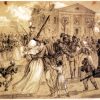calsfoundation@cals.org
White River Expedition (February 4–8, 1864)
| Location: | White River; Big Creek; Boyce Plantation; Helena, Arkansas |
| Campaign: | White River Campaign |
| Dates: | February 4–8, 1864 |
| Principal Commanders: | Captain Charles O’Connell (US); unknown (CS) |
| Forces Engaged: | Fifteenth Illinois Cavalry, Third Arkansas Infantry (African Descent), seven artillery men (US); unknown Confederate cavalry |
| Casualties: | 7 captured (CS) |
| Result: | Union advancement on the White River to Helena, Arkansas |
Embarking on the steamer Cheek on a scouting expedition on February 4, 1864, Captain Charles O’Connell led a Union expeditionary force from Helena (Phillips County) up the White River. He commanded 100 men of the Fifteenth Illinois Cavalry; forty men of the Third Arkansas Infantry, African Descent under Captain John W. Robinson; and one piece of artillery and seven artillerymen of the Second U.S. Colored Light Artillery, Battery E under Lieutenant John C. Haddock. Embarking from Helena at 9:00 a.m., the small collection of Union forces destroyed one flat boat prior to reaching Friars Point at 11:00 a.m., where they saw four cotton boats and discovered their gunboat had been ordered to Memphis, Tennessee, and the steamer White to return to Helena. After their departure, the remaining portion of the Union expedition arrived at Island 63 and then Island 66 by 2:20 p.m. The steamer Emerald at this point stopped to take on wood and arrived at the commanding post on Island 66 at 6:00 p.m., where the steamer delivered dispatches and deployed cavalry. The steamer remained at the mouth of the White River until morning, however, as it was deemed unsafe to travel upriver at night.
In the early morning of February 5, Capt. O’Connell moved up the White River without a convoy and stopped at the mouth of Big Creek, roughly three miles below Indian Bay at 5:30 p.m.. The cavalry disembarked for feed and water while taking in more wood. (Meanwhile, Confederate colonel Robert Murphy Mayo and Captain Caleb Davis’s companies moved to General Dandridge McRae’s headquarters in Indian Bay Landing, near their location.) A cavalry scout disembarked from the convoy and arrived at the headquarters by 2:30 a.m., where their orders were to leave Captain John Robinson and the Third Arkansas in command of the boat. It would be Robinson’s responsibility to depart from the docking after twenty-four hours without notice and to return to Helena. During the travel to Colonel William J. Boyce’s plantation, O’Connell captured five prisoners at houses on the road, arriving at the plantation by 8:30 p.m. He received information from Col. Boyce that companies commanded by Mayo and Davis returned to Gen. McRae’s headquarters in order to establish a battalion and return to the vicinity within the next ten days. Boyce informed O’Connell that he had one pistol and fifteen bales of cotton hidden from the Rebels, at which point O’Connell retrieved the pistol. Boyce informed O’Connell that Lieutenant T. C. Casteel’s company was currently encamped within three and a half miles of the Boyce plantation.
Immediately, O’Connell moved to within one-half mile of the encampment, where he discovered a black man who had recently returned from the picket. Arresting him, O’Connell forced him to pilot the cavalry to the camp, where they halted their movements at a cypress swamp on the opposite side of the picket. Viewing eighteen Confederates mounted across the swamp, O’Connell signaled to fire at the picket and then commenced the charge, which failed initially, as O’Connell reported that the cavalry could only file through by twos through the swamp, given that the water and mud reached four feet deep at times. Reaching the end of the swamp, the cavalry discovered the Confederates scattered over the hill and through the woods. Their orders were to charge through the thick and miry woods in order to capture or kill as many as possible. After two miles, the cavalry stopped. O’Connell captured two prisoners, four horses, and six guns, as well as the enemy’s encampment and equipment. The encampment and a portion of the equipment were then burned.
O’Connell then turned his cavalry to Big Creek, where the horses delayed the journey, as they had not recovered from the exhaustion of the recent skirmish. The group embarked on a boat following a short resting period at 6:00 p.m. and proceeded to Big Creek. Then the ship joined a gunboat convoy and waited until the early morning on February 7 before proceeding to the mouth of the White River, arriving there at noon. The force then moved into the Mississippi River to Helena, where it arrived at the wood-yard at Helena at 3:00 a.m. on February 8. During this expedition, O’Connell captured seven prisoners, sixteen horses, three mules, and six Colt revolvers, and managed to destroy twelve guns. He also reported that there were roughly fifty bales of cotton at the Indian Bay settlement, 5,000 bushels of corn there, and, within five miles, another 25,000 bushels of corn. This scouting report is an excellent example of the Union expeditions during 1864.
For additional information:
The War of the Rebellion: A Compilation of the Official Records of the Union and Confederate Armies. Series I, Vol. 34, Part I, pp. 126–127. Washington, DC: Government Printing Office, 1891.
Matthew Whitlock
Old Dominion University
 Black Union Troops
Black Union Troops Civil War Timeline
Civil War Timeline Military
Military ACWSC Logo
ACWSC Logo 




Comments
No comments on this entry yet.